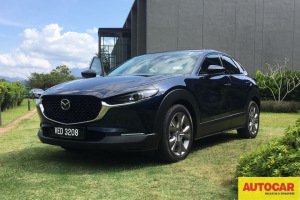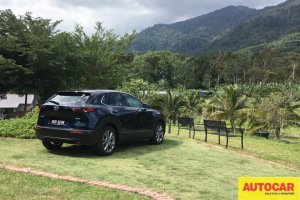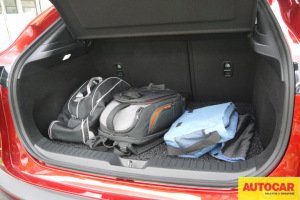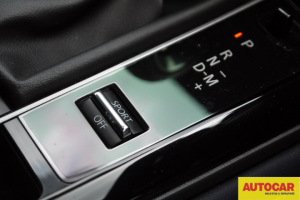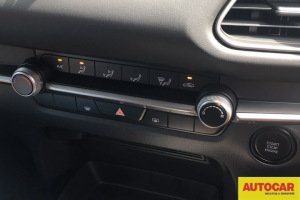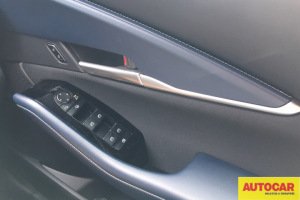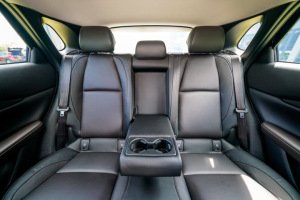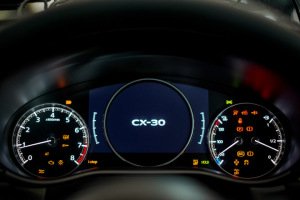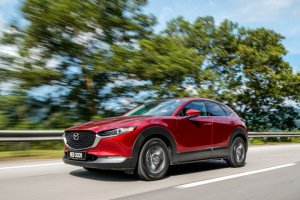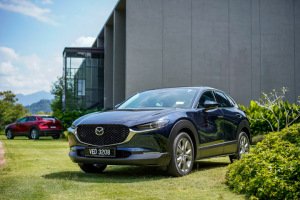
The Mazda CX-30 SUV Skyactiv-G 2.0 shows that base model doesn’t mean basic.
What is it?
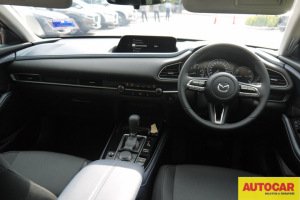 The CX-30 is Mazda’s latest small SUV, built on the same platform as the current, fourth generation Mazda3. The all-new model slots in between the CX-3 and the CX-5 for size. There are three variants and two trim levels. The petrol in basic and High spec, and a High spec diesel. We drove the entry-level, 2.0-litre petrol-engined Mazda CX-30 Skyactiv-G. The CX-30 is only available with front-wheel drive in Malaysia.
The CX-30 is Mazda’s latest small SUV, built on the same platform as the current, fourth generation Mazda3. The all-new model slots in between the CX-3 and the CX-5 for size. There are three variants and two trim levels. The petrol in basic and High spec, and a High spec diesel. We drove the entry-level, 2.0-litre petrol-engined Mazda CX-30 Skyactiv-G. The CX-30 is only available with front-wheel drive in Malaysia.
What is it like?
The Kodo design theme makes it immediately recognisably a Mazda. The small but intently peering headlights, large expanses of sheet metal creased at key points to create a muscular yet elegant form. From its front and sides, the CX-30 could be mistaken for a heavier set Mazda3. From the rear, it has more than a passing resemblance to the Alfa Stelvio.
CX-30 is impressive for safety. The base CX-30 does not have i-Activsense, the advance autonomous safety features that are standard in the High spec. However, the SUV does come with safety features which could rival those of higher-spec models one segment up. Seven airbags are standard including driver’s side knee-bags which is Mazda’s new global standard equipment. There are also the established minimums: ABS, stability control, traction control, emergency stop signal and hill launch assist.
In the Euro NCAP safety tests, the CX-30 scored an overall Adult Occupant rating of 99 per cent, largely due to the new Skyactiv-Vehicle Architecture around which the SUV is built. Skyactiv-Vehicle Architecture, introduced in the Mazda3, is about controlling passengers’ centres of gravity to ensure that ride comfort, handling, and stability are in harmony with the vehicle’s motions. The impact-absorbing body shell ensured the CX-30 scored highly in every collision test including securing maximum points for some of them, making the CX-30 one of the safest cars on the road.
Most base spec cars are given the barest minimum or obviously lower cost alternatives. Externally, our test car only differed from the High spec on two features, the rim size and headlight type. There were 16-inch rims on our car while the High spec has the more rugged-looking 17. The front and rear lights on both trim levels are LED but the lower model does without the signature lighting design. Our car had twin exhaust pipes which made it look even more impressive.
Inside, the cabin looked and felt premium with metal and leather inserts on the door. Our car was fitted with equipment associated with higher trim level models like push-button ignition, electronic parking brake, leather gear knob, multi-function steering wheel, automatic headlights and rain sensing wipers. Standard in both trim levels were LED cabin lights, colour TFT LCD multi info instrument cluster, colour heads-up display, 8.8-inch full colour infotainment display, speakers, Apple CarPlay/ Android Auto, Mazda Connect with voice command and the Commander Control found in the High spec. What the lower spec didn’t have were paddle shifts, rear aircon vents, automatic climate control or a sunroof.
The interior is laid out to maximise passenger comfort and driver convenience with the switches, buttons, and knobs angled towards the driver. The multi-info LCD instrument panel was easy to read. We liked the seatbelt warning which also showed which passenger wasn’t properly fastened in.
Aside from the fabric upholstery, instead of leather, the , supportive sports-style seats in both specs were the same. There was plenty of room to adjust the front seats rearwards and still have reasonable wriggle legroom for a full-sized adult. The backs of the split-fold rear seats were not reclinable but the angle was comfortable and there was decent back support, although for long distances, rear passengers might want to take an extra cushion or two. The boot was generous enough to have accommodated more than a weekend’s worth of luggage.
Good looks and assured handling that makes the CX-30 a pleasure to drive whether it’s a relaxing meander or an all-out mountain sprint. The latest generation Gravity Vectoring Control Plus in the CX-30 made a palpable difference to passenger comfort – I was able to nap through a spirited exploration of the Genting curves up and back down again. The damping effect of the Skyactiv-Vehicle Architecture structure kept down noise intrusion and vibrations so the CX-30 remarkably quiet and smooth on the road.
Would I get one?
The CX-30 is pricey and that’s the biggest drawback hence the three-and-a-half stars rating. The Mazda CX-30 is worthy of far more stars than we’ve awarded.
However, it’s hard to justify RM143,000 when the larger, entry-level CX-5 is almost RM10,000 less: same output but 3Nm lower torque and one less airbag, amongst a few other minor differences.
Price RM143,059 (OTR)
On sale Now
Engine In-line 4 cyl, 1,998cc, naturally-aspirated petrol
Power 162 bhp at 6000rpm
Torque 213 Nm at 4000rpm
Gearbox 6-spd automatic
Kerb weight 1,441 kg
Top speed 196 km/h (claimed)
0-100km/h N/A

